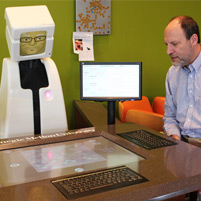SCRABBLE Score

Victor challenges the Robotics Institute's Reid Simmons.
Victor plays a mean game with words.
The trash-talking Carnegie Mellon University robot is showing how machines and humans interact through playing a classic board game.
Call him a gamebot.
Victor is obsessed with SCRABBLE. Seated in a corner of a student lounge on the third floor of the Gates Center, Victor plays anyone who pulls up a stool. He's ready with a taunt — "Is that all you've got?" — as well as a brag — "This one is going to be good." And he has plenty of excuses — "Dude, I let you win."
His edgy personality was developed by an interdisciplinary group of researchers led by Reid Simmons, research professor in CMU's Robotics Institute. The project is investigating questions such as whether changes in mood or emotions affect the desire to interact with robots and how personalization, such as the robot remembering a person's play from previous games, might affect the willingness to interact over time.
The research team includes collaborators from such varied disciplines as robotics, computer science, drama, design and entertainment technology.
Victor moves his tiles electronically on a table-size touchscreen; but he has a torso and mobile head on which a screen displays his animated face. The face was designed by Anne Mundell, associate professor of scene design.
During a game, the robot will bow his head in concentration and look a player in the eyes when critiquing a move. A light over his heart can change color and pulsate at different speeds depending on his mood. Eventually, the researchers will enable him to recognize previous players and to calibrate his play to the level of his opponents.
Victor has a voice to address his opponents, and people converse through keyboards.
Michael Chemers, now an associate professor of theater arts at the University of California, Santa Cruz, designed the character — the precocious son of a pair of Detroit industrial robots attending CMU on a SCRABBLE scholarship — and wrote much of his dialogue. He also maintains Victor's Facebook page.
Other contributors include Maxim Makatchev, a post-doctoral fellow in robotics, Greg Armstrong, senior research technician in the Robotics Institute, and numerous undergraduate and graduate students.
With Victor, Simmons and fellow researchers hope to better understand what it takes to get people to not only engage with a robot, but to enjoy doing it.
"We believe that for autonomous robots to be accepted, they will have to conform to the social conventions of people, rather than the other way around," Simmons said.
Though people can't see Victor's letter tiles, they can see each other's tiles on the touchscreen. One consequence is that people tend to gang up when playing against Victor, Simmons said.
"They don't care if they lose to each other, but they don't want to lose to a machine," he said.
This research was supported in part by a grant from the Qatari National Research Fund.
Related Links: Robotics Institute | Wall Street Journal article | Press Release: Carnegie Mellon Robot Invites Humans To Play Mean Game of SCRABBLE | SCRABBLE, Anyone? | Robotic Smiles
